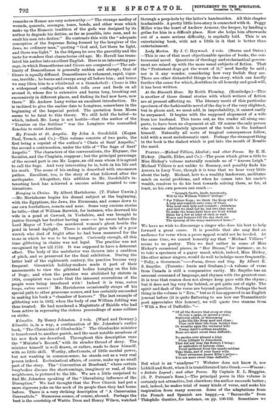with the Egyptians, the Jews, the Etruscans, and comes down
to our own forefathers, remote and near. Some very curious stories he tells,—that of William Barwick, for instance, who drowned his wife in a pond at Cawood, in Yorkshire, and was brought to justice through her brother having seen—so he swore before the Lord Mayor of York—the murdered woman's ghost beside the pond in broad daylight. There is another grim tale of a poor wretch who died of fright after he had been measured for the irons in which he was to be hanged. Curiously enough, all this time gibbeting in chains was not legal. The practice was not recognised by law till 1752. It was supposed to have a deterrent effect. The body of the malefactor was thrown into a cauldron of pitch, and so preserved for the final exhibition. During the
latter half of the eighteenth century, the practice became very frequent. Greenwich holiday-makers made it part of their
amusements to view the gibbeted bodies hanging on the Isle of Dogs; and when the practice was abolished by statute in 1834, complaint was made that the innocent recreations of the
people were being interfered with ! Indeed it is true, autres temps, autres mows ! Mr. Hartshorne occasionally strays off his special path to other gruesome scenes, and has certainly succeeded
in making his book a "chamber of horrors." The last example of gibbeting was in 1832, when the body of one William Jobling was thus treated. He had murdered a Magistrate of Shields who had been active in repressing the riotous proceedings of some colliers on strike.


















































 Previous page
Previous page